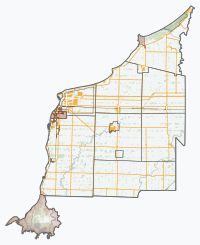Enniskillen, Ontario
Enniskillen | |
|---|---|
| Township of Enniskillen | |
 Oil City hamlet | |
| Coordinates: 42°49′N 82°7.5′W / 42.817°N 82.1250°W | |
| Country | Canada |
| Province | Ontario |
| County | Lambton |
| Settled | 1830s |
| Incorporated | 1855 |
| Government | |
| • Mayor | Kevin Marriott |
| • Federal riding | Sarnia—Lambton |
| • Prov. riding | Sarnia—Lambton |
| Area | |
| • Land | 338.05 km2 (130.52 sq mi) |
| Population (2021)[1] | |
| • Total | 2,825 |
| • Density | 8.4/km2 (22/sq mi) |
| Time zone | UTC-5 (EST) |
| • Summer (DST) | UTC-4 (EDT) |
| Postal Code FSA | N0N |
| Area code(s) | 519, 226, 548 |
| Website | www |
Enniskillen is a township in the Canadian province of Ontario, within Lambton County. It is located at the intersection of Highway 21 (Oil Heritage Road) and Rokeby Line. The economy of the township is based on agriculture. It was named after Sir Galbraith Lowry Cole's father who was the Earl of Enniskillen, Northern Ireland.
Communities
[edit]The township comprises the communities of Oil City, Glen Rae and Marthaville, and surrounds but does not include the independent municipalities of Petrolia and Oil Springs.
Demographics
[edit]In the 2021 Census of Population conducted by Statistics Canada, Enniskillen had a population of 2,825 living in 1,041 of its 1,087 total private dwellings, a change of 1% from its 2016 population of 2,796. With a land area of 338.05 km2 (130.52 sq mi), it had a population density of 8.4/km2 (21.6/sq mi) in 2021.[1]
| 2021 | 2016 | 2011 | |
|---|---|---|---|
| Population | 2,825 (+1.0% from 2016) | 2,796 (-4.6% from 2011) | 2,930 (-6.1% from 2006) |
| Land area | 338.05 km2 (130.52 sq mi) | 338.16 km2 (130.56 sq mi) | 338.18 km2 (130.57 sq mi) |
| Population density | 8.4/km2 (22/sq mi) | 8.3/km2 (21/sq mi) | 8.7/km2 (23/sq mi) |
| Median age | 47.2 (M: 44.0, F: 48.4) | 49.1 (M: 47.2, F: 50.5) | |
| Private dwellings | 1,087 (total) 1,041 (occupied) | 1,093 (total) | 1,124 (total) |
| Median household income | $104,000 | $89,728 |
|
|
| |||||||||||||||||||||||||||||||||||||||||||||||||||||||||||||||
| Source: Statistics Canada[7][8][9][10] | |||||||||||||||||||||||||||||||||||||||||||||||||||||||||||||||||
See also
[edit]References
[edit]- ^ a b c "Enniskillen, Ontario (Code 3538016) Census Profile". 2021 census. Government of Canada - Statistics Canada. Retrieved 2024-09-26.
- ^ "2021 Community Profiles". 2021 Canadian census. Statistics Canada. February 4, 2022. Retrieved 2023-10-19.
- ^ "2016 Community Profiles". 2016 Canadian census. Statistics Canada. August 12, 2021. Retrieved 2019-06-17.
- ^ "2011 Community Profiles". 2011 Canadian census. Statistics Canada. March 21, 2019. Retrieved 2012-02-09.
- ^ "2006 Community Profiles". 2006 Canadian census. Statistics Canada. August 20, 2019.
- ^ "2001 Community Profiles". 2001 Canadian census. Statistics Canada. July 18, 2021.
- ^ "1971 Census of Canada - Population Census Subdivisions (Historical)". Catalogue 92-702 Vol I, part 1 (Bulletin 1.1-2). Statistics Canada: 76, 139. July 1973.
- ^ 1996, 2001, 2006 census
- ^ "Enniskillen census profile". 2011 Census of Population. Statistics Canada. Retrieved 2012-02-09.
- ^ "Enniskillen, Ontario (Code 3538016) Census Profile". 2016 census. Government of Canada - Statistics Canada.
External links
[edit]


 French
French Deutsch
Deutsch
